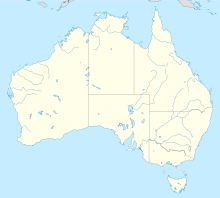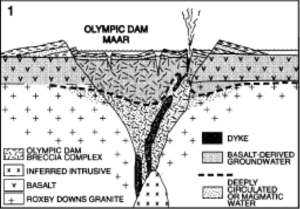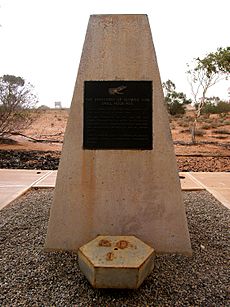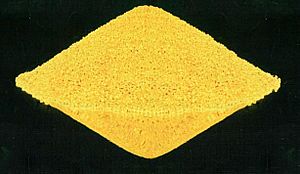Olympic Dam mine facts for kids
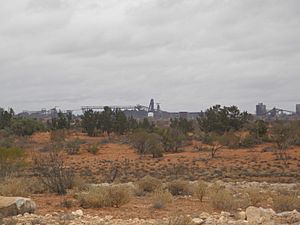
Clarke and Robinson shafts (centre)
|
|
| Location | |
|---|---|
| Location | Olympic Dam |
| State | South Australia |
| Country | Australia |
| Coordinates | 30°26′24″S 136°52′23″E / 30.44000°S 136.87306°E |
| Production | |
| Products | copper uranium oxide gold silver |
| Type | Underground |
| History | |
| Opened | 1988 |
| Owner | |
| Company | BHP |
| Year of acquisition | 2005 |
The Olympic Dam mine is a very large underground mine in South Australia. It's about 550 km (340 miles) northwest of Adelaide. This mine is famous for being the fourth largest copper deposit in the world. It also holds the biggest known single deposit of uranium.
Copper brings in most of the money for the mine, about 70% of its total earnings. Uranium makes up about 25%, and silver and gold contribute the rest. The company BHP has owned and run the mine since 2005. Before that, it was owned by Western Mining Corporation.
Since the 1970s, some groups have spoken out against the mine. These include environmentalists and traditional owners of the land. Their main concerns are how the mine relates to the nuclear industry and its use of underground water.
The mine opened in 1988. Since then, a huge underground network has been built. There's also a plant to process the metals and large areas to store waste. The nearby town of Roxby Downs and the Olympic Dam mining centre support the mine. They provide homes and services for the workers. There are even daily flights to and from Adelaide at the Olympic Dam Airport.
BHP once planned to make the mine much bigger. This would have involved digging a new open cut pit and building lots of new facilities. However, in 2012, these expansion plans were put on hold. The company decided to look for a "new and cheaper design" instead.
Contents
What Does the Mine Produce?
The Olympic Dam mine is a major producer of important metals. As of 2013, it was the second largest uranium-producing mine in the world. It produced 4,100 tonnes of uranium metal in the year ending June 2013. Only the McArthur River uranium mine in Canada produced more.
Uranium is a special metal used to create energy in nuclear power plants. It has a lot of energy packed into a small amount. For example, the uranium produced here in one year could create as much energy as burning millions of tonnes of coal! The mine also produces a lot of copper, gold, and silver.
How the Mine Started
The Olympic Dam deposit was first found in 1975. In 1979, two companies, Western Mining Corporation and BP Minerals, teamed up to start the mine. A special law was passed in 1982 to help the project move forward.
The first mine shaft was built that same year. It was named the Whenan Shaft after Ted Whenan, one of the people who discovered the ore. The new town of Roxby Downs was also created in 1982. It was meant to be a place for mine workers and their families to live.
In 1983, the mine got approval to start producing copper. The goal was to produce up to 150,000 tonnes each year. It took more than ten years to reach this goal.
In 1987, a new entrance to the mine was made. The mine also got connected to South Australia's electricity network. The Olympic Dam mine officially opened in 1988. The first shipments of copper cathodes (pure copper) and uranium oxide (yellowcake) were sent out. The town of Roxby Downs also officially opened, and its local newspaper started. In 1989, the mine produced its first gold and silver bars.
Growing Bigger
In 1993, Western Mining Corporation bought BP's share and took full control of the mine. The mine then went through several stages of growth. In 1986, the target was 45,000 tonnes of copper per year. By 1992, it reached 66,000 tonnes, and in 1995, it hit 84,000 tonnes.
A big expansion was announced in 1996. The aim was to produce 200,000 tonnes of copper each year. Another environmental approval was given, allowing the mine to produce up to 350,000 tonnes of copper annually.
In 1998, the mine poured its 500th bar of gold. Two years later, in 2000, it produced 200,000 tonnes of copper in a single year for the first time. By making things more efficient, the output increased to 235,000 tonnes per year in 2002.
New Ownership and Future Plans
In March 2005, BHP successfully bought Western Mining Corporation. This made BHP the new owner of the Olympic Dam mine. After this, BHP started planning a huge expansion project. This plan involved digging a new open cut mine.
This expansion was expected to create many jobs, possibly 23,000 direct and indirect jobs. It would have also required building major new facilities. These included a new airport at Olympic Dam, a rail link, and a plant to remove salt from seawater at Point Lowly. There would also be a place for barges near Port Augusta and a village for workers near Andamooka.
The government of South Australia even created a special group, the Olympic Dam Task Force, in 2006. This group helped BHP with its plans. BHP also started working with universities and research groups. They wanted to support studies related to mining, the environment, and policies.
Working with Universities
Since BHP took over, several universities in South Australia have done research related to the Olympic Dam mine. BHP has helped fund some of this research. For example, Flinders University looked at future job needs for the mine. The South Australian Museum researched new "liquid mining" methods. The Environment Institute and Institute for Mineral and Energy Resources (IMER) at the University of Adelaide also did many studies. The Ian Wark Research Institute at the University of South Australia also had many projects.
In 2008, the Ian Wark Research Institute started a partnership with BHP. BHP promised to give $500,000 each year for five years for research. In 2012, the Institute for Mineral and Energy Resources at the University of Adelaide received over $2.5 million for a research hub. This hub would focus on improving copper-uranium production. BHP also partnered with IMER on this project, providing money and other support.
Some BHP executives have also been part of advisory boards at these universities. This shows how closely the company works with academic groups.
Industry Connections and Support
BHP Olympic Dam is a member of the World Nuclear Association. This group aims to help people understand nuclear energy better. BHP Billiton is also a member of the Minerals Council of Australia's Uranium Forum. These groups help represent the interests of the Olympic Dam project in the mining industry.
BHP also sponsors different events and groups. Some of these are directly linked to its uranium business, which is mainly the Olympic Dam mine. For example, in 2016, BHP Billiton was a main sponsor of a conference for radiation protection experts in Adelaide. Tours of the Olympic Dam mine have also been offered to people attending mining conferences in South Australia.
Plans for Expansion
When BHP took over, the previous owner was already looking into ways to expand the mine. This included thinking about a plant to remove salt from seawater at Port Bonython (Point Lowly).
In 2008, BHP finished a study about expanding the mine. The first part of the expansion was planned for late 2013. In December 2008, South Australia's Premier Mike Rann announced that BHP would go ahead with an open-cut mine.
While governments welcomed the expansion as a boost for the economy, it also received criticism. In 2007, BHP Billiton was criticized for delaying the release of its environmental report for the expansion. People also questioned some of the details of the proposed plan.
In May 2009, the company released a detailed environmental report for public review. It showed the plans for building and running the expanded mine. New facilities would include:
- A desalination plant at Point Lowly (Port Bonython)
- A rail link to Pimba
- A village for workers between Olympic Dam and Andamooka
- A facility for barges near Port Augusta
In May 2011, the company released an updated environmental report. This was in response to over 4,000 comments received from the public. On October 10, 2011, both state and federal governments approved the mine expansion.
Seawater Desalination Concerns

Removing salt from seawater was considered by Western Mining Corporation as early as 1997. But at that time, it was thought to be too expensive and bad for the environment. By 2005, they looked at it again.
To get enough water for the expanded mine, BHP Billiton planned to build a large plant at Point Lowly. This plant would use a process called reverse osmosis to remove salt from seawater. The clean water would then be pumped over 300 km (186 miles) north to the mine and Roxby Downs.
The location of this plant caused debate. This is because the very salty water (brine) released from the plant would be discharged near an important breeding area for the Giant Australian Cuttlefish. These amazing creatures are sensitive to increases in ocean saltiness.
In August 2009, a South Australian government committee suggested BHP Billiton look for other locations for the plant. They believed the salty water could harm the marine life in the upper Spencer Gulf.
Between 2010 and 2011, three petitions were sent to the South Australian Parliament. They were signed by 910 people who wanted the desalination plant moved. They wanted the salty water to be released into the open ocean, not into Spencer Gulf.
In February 2012, Arabana elder Kevin Buzzacott legally challenged the government's approval of the mine expansion. His case was heard in court but was dismissed. An appeal in 2013 was also unsuccessful.
In July 2012, over 400 people joined a protest called "Lizard's Revenge" at the Olympic Dam site. These anti-nuclear activists, including Kevin Buzzacott, protested against the mine expansion and the uranium industry. They argued that the company and government were putting money ahead of environmental and health concerns.
The original development of the mine in the 1980s also faced public opposition. There were many protests and demonstrations, with hundreds of arrests.
In August 2012, BHP Billiton announced that the expansion was put on hold. They wanted to find a "new and cheaper design." The South Australian government expressed mixed feelings. Some believed the project would still bring prosperity, while others warned BHP that future approvals might be harder to get. Eight months later, the town of Roxby Downs was reportedly struggling.
In December 2013, the federal government supported bringing back the Olympic Dam expansion project. This came after news that Holden would stop making cars in South Australia in 2017. Some business leaders in South Australia believe the state should not rely only on the Olympic Dam expansion. They think the government should support a wider range of businesses.
In September 2014, the mine received environmental approval to start trials of a new processing method called heap-leaching. This was an effort to lower costs. In 2015, the mine started reducing its workforce to cut operating costs.
How the Mine Works
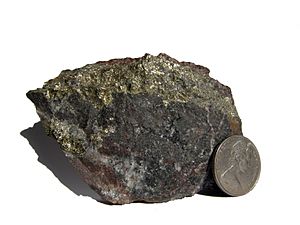
The Olympic Dam mine digs into a very large deposit of iron oxide copper gold. It's estimated to hold 2.95 billion tonnes of ore. This ore contains about 1.2% copper, 0.04% uranium, 0.5 grams per tonne of gold, and 6 grams per tonne of silver.
The mine uses an underground mining method called sublevel open stoping. This involves digging out large sections of rock from below. Modern and efficient mining equipment is used. In March 2005, the mine was producing 9.1 million tonnes of ore each year. This makes it one of Australia's largest mines. In 2005, it produced over 220,000 tonnes of copper, 4,500 tonnes of uranium oxide, plus gold and silver.
The copper and uranium oxide are sent out through Port Adelaide. Most of the mine workers live in the nearby towns of Roxby Downs and Andamooka. Regular flights connect Adelaide and the Olympic Dam Airport for the mine project.
Uranium Production
Uranium production at Olympic Dam makes up about 25% of the mine's income. Since 2013, Olympic Dam has been Australia's biggest producer of uranium oxide, also known as 'yellowcake'.
| Year | Tonnes U3O8 |
|---|---|
| 2006-07 |
3,474
|
| 2007-08 |
4,115
|
| 2008-09 |
3,974
|
| 2009-10 |
2,258
|
| 2010-11 |
4,012
|
| 2011-12 |
3,853
|
| 2012-13 |
4,064
|
| 2013-14 |
3,988
|
| 2014-15 |
3,144
|
| 2015-16 |
4,363
|
| 2016-17 |
3,661
|
Electricity Supply
The Olympic Dam mine uses more electricity than any other single user in South Australia. It is connected to the main power grid. In 2009, BHP Billiton said the mine used about 870,000 MWh of electricity each year.
A big storm and heatwaves in 2016 caused problems for the mine's production. This led the state to start projects to make the power grid more reliable. The mine has now ordered 210 MW of wind power from the Goyder South Wind Farm. It also ordered 110 MW of solar power. In February 2024, construction started on a large battery storage system near Blyth.
Water Supply
The Olympic Dam mine uses 35 million litres of water from the Great Artesian Basin every day. This makes it the biggest industrial user of underground water in the southern hemisphere. The water is pumped through an underground pipeline from two areas about 110 km and 200 km north of the mine. This underground water is salty, so it needs to be desalinated (have the salt removed) before it can be used.
Water that gets contaminated from mining operations is put into a series of sealed ponds where it evaporates. About 3 million litres of the daily water supply goes to the town of Roxby Downs. The amount of water used has grown a lot since the 1990s. In 1995, the mine and Roxby Downs together used about 14.3 million litres of water daily.
The large amount of underground water used by the mine is a concern for the environment. It can affect nearby mound springs. Mound springs are the only natural water sources in the dry interior of South Australia. They support unique plants and animals that have adapted to these isolated water spots. If the water flow to these springs is reduced, it can harm these special ecosystems.
Air Pollution
The Olympic Dam processing plant releases some pollution into the air. These emissions are reported every year. As of 2013, the main pollutants released in amounts over 500 tonnes per year were:
- Small particles (dust)
- oxides of nitrogen
- sulfur dioxide
- carbon monoxide
Government Support
In 2006, the Government of South Australia created the Olympic Dam Task Force. This group was set up to help BHP Billiton with their mine expansion plans. Paul Heithersay is the Chief Executive of this task force. He also serves as Deputy Chief Executive for the Department of State Development. Some other senior government workers have also worked for BHP Billiton or Western Mining Corporation on the Olympic Dam project.
Images for kids
-
The amazing Point Lowly cuttlefish gather here. There were worries the desalination plant's salty water might harm them.
-
A rock sample rich in Chalcopyrite ore from Olympic Dam.


